What is a septic tank?
This post explains all you need to know about septic tanks
PUBLIC HEALTH ENGINEERING
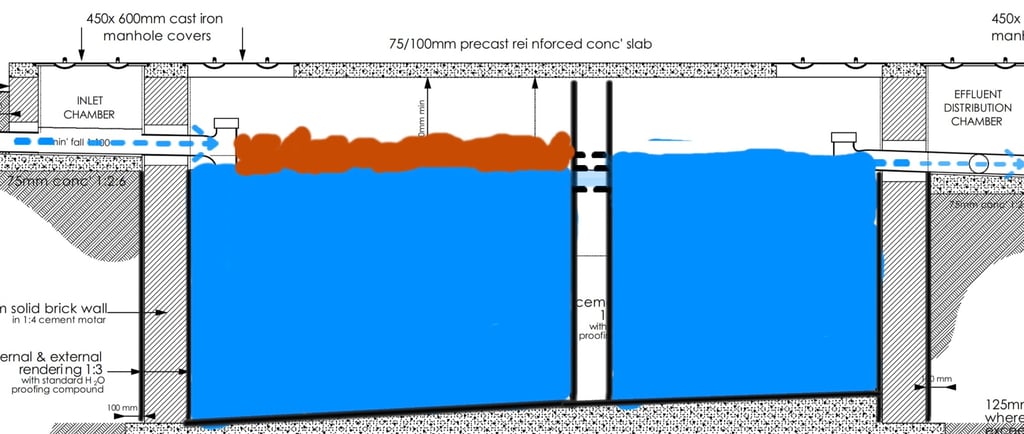

Table of contents
1. Main Idea
2. What is a septic tank?
3. How a septic tank actually works
4. How to maintain your septic tank to keep it healthy
5. How often should you pump your septic tank?
6. How much does a septic tank cost?
7. How to build septic tanks the right way
Introduction
In this article you are going to learn all you need to know about septic tanks
Clearly understanding how septic tanks work, their maintenance needs, and how they are built the right way is crucial for homeowners who rely on them. Proper care does not only ensure efficient performance but also protects your property, health, and the environment.
Let’s first clearly understand what a septic tank means
What is a septic tank?
A septic tank is an underground container that treats wastewater from houses and puts it back into the groundwater system.
In simple terms, everything from flush from the toilets, sinks, showers, laundry ends up underground soil with the help of the septic tank
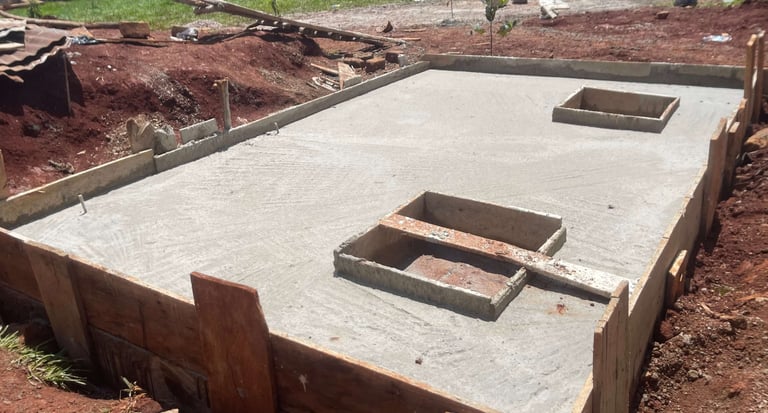

How does a septic tank work?
Sewage comes from the house through this inlet pipe; once it reaches inside, it separates into 3 layers: solid sewage or sludge, at the bottom; liquid sewage as the middle layer; and scum on top
Scum here on top includes, feminine products, baby diapers or pampers, fats and oils, plastics and other non-biodegradable products
Once the sewage reaches here inside the septic tank, bacteria grows naturally to break down the sludge into liquid sewage
Once it reaches this level it flows to the second chamber
The purpose of providing more than 1 chamber for your septic tank is to ensure that sewage undergoes further clearing and settling before it enters the second chamber
It then fills up to the level of the outlet pipe and flows to the soak pit. This pipe from the septic tank to the soak pit is usually sloped. To enable seamless flowing of the liquid sewage
And then from the soak pit, the liquid sewage flows underground back into the groundwater system.
And the process continues like that every time you use your toilet.
To simplify this, let me use these 2 containers to illustrate how the septic tank system actually works
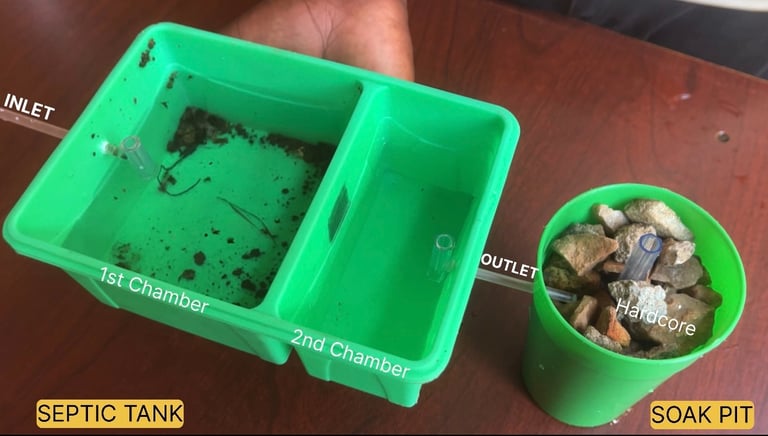

So, a septic tank is made up 2 items
Consider the first rectangular container as the septic tank itself, and consider the circular item as a soak pit
A septic tank has 2 chambers: the first chamber which is bigger and the second chamber which is slightly smaller, with a separating wall in the middle
When building the septic tank, we install an inlet pipe to this bigger side and then install the outlet pipe at this smaller side
This pipe exiting the septic tank connects to the soak pit. The soak pit is usually having a heavy-duty pvc pipe at the centre of the pit with holes in it
We then fill the soak pit with hardcore or stones. We then cast a slab on top of the septic tank to have a complete structure
When wastewater or sewage comes from the house and enters the first chamber of the septic tank, it fills up and then flows to the second chamber and once it reaches the level of the outlet pipe, it flows to the soak pit
And then from the soak pit to the surrounding soil. The process continues like that every time you use your toilet
And this brings us to our 2nd topic,
How to maintain a septic tank
Which, this is the most important part of this video
1. Avoid flushing non-biodegradable products into the septic tank. avoid flushing plastics, shavers, polythene bags, pampers, as they block the septic tank
2. You must fill the septic tank with water before using it. Since septic systems rely on anaerobic bacteria to break down solids.
· Filling with clean water gives the system a starting liquid base, making it easier for bacteria to start working when wastewater enters.
Pre-filling helps equalize pressure, reducing stress on walls
Summary
Filling the septic tank with water:
Prevents it from floating or shifting
Supports early bacterial activity
Protects the tank structure
Helps the system operate smoothly from the start
The third way to maintain a septic tank is to
2. Watch What You Flush
Only flush:
· Human waste
· Toilet paper (preferably septic-safe)
Never flush:
· Grease, oils, or fats
· Wipes (even if labeled "flushable")
· Feminine hygiene products
· Diapers, paper towels
· Harsh chemicals or medications
This brings us to the third topic of
Waste management
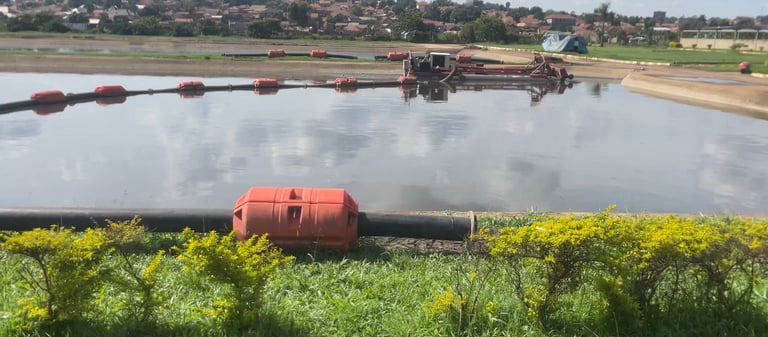

How often should you pump your septic tank?
It entirely depends on how your septic tank was built. Workmanship plays a big role. If your septic tank was built badly, you will need pumping every 3-5 years
If your septic tank was built the right way, you will never need pumping, even after 40 years.
And by the end of this video, I’ll show you how to build a septic tank the right way such that you will never need pumping
Actually I can make for you septic tank drawings or plans that your builders can follow to build a standard septic tank that will never need pumping even after 40 years
To buy these septic tanks drawings and BOQ, the link is in the description
This brings us to the 4th topic
How much does it cost to pump a septic tank?
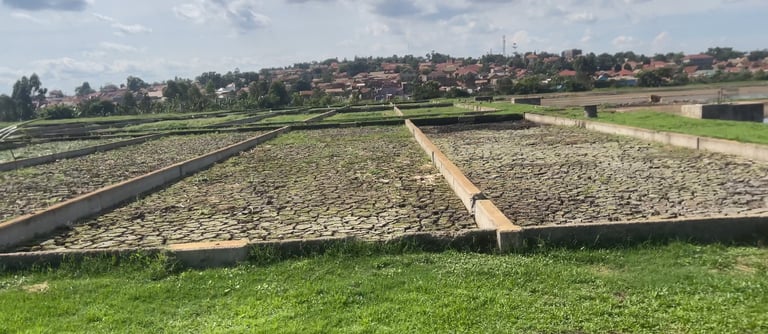

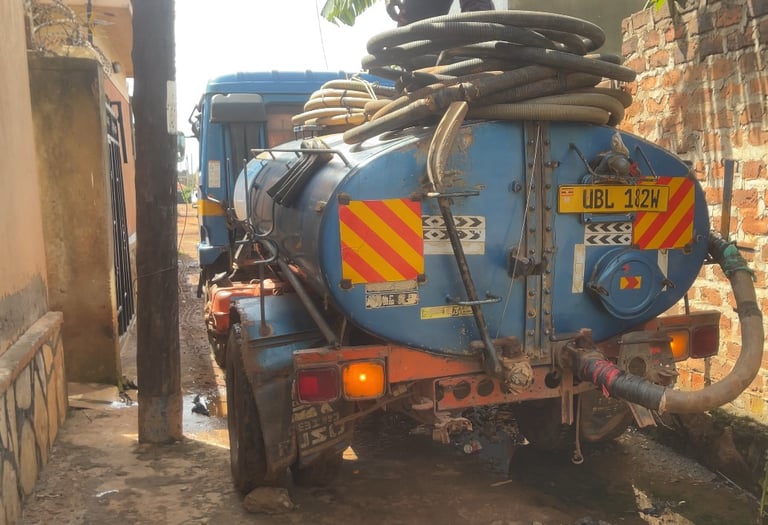

For a truck of 5000 liters, it will cost around 80 usd to fill it up and take the sewage to the sewage treatment plant, depending on your location
For 1000 litres, it will cost around 160 USD depending on your location, so generally the cost is 80 USD for every 5000 litres.
To cut all these costs involved for every 2 years,
As a civil engineer who has built over 50 septic tanks, I can assure you all problems affecting septic tanks come from building them the wrong way; it all starts with poor workmanship
Building a septic tank the correct way will save you a lot of money in the long run
And this brings us to the last topic
How do we build a septic tank the correct way
There are common types of septic tanks.
A two-compartment septic tank
A one-compartment septic a tank
A plastic septic tank
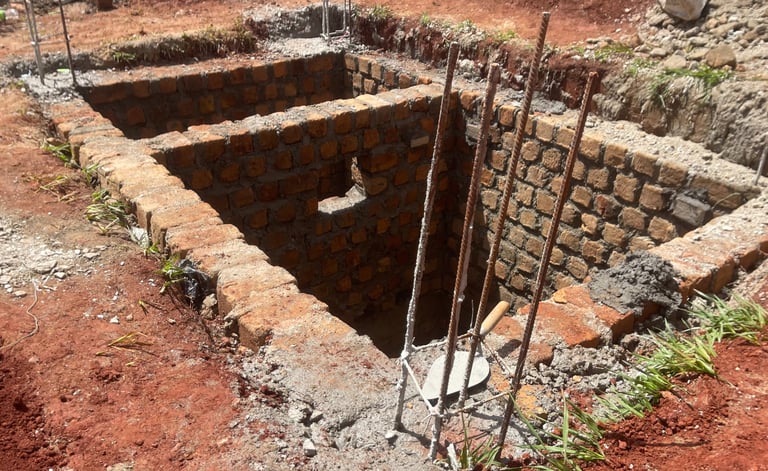

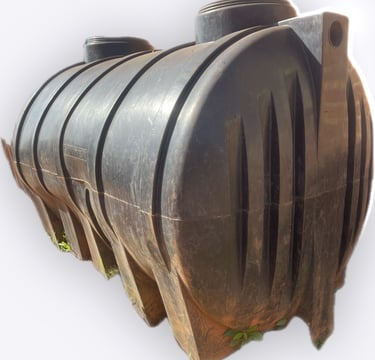

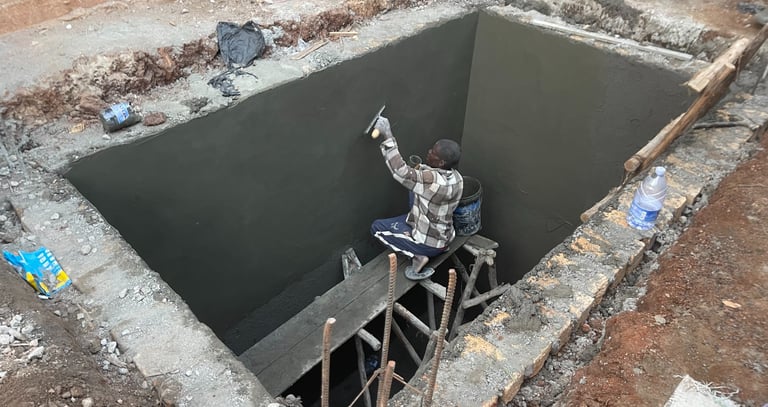

I don’t recommend using plastic septic tanks unless it's temporary.
I recommend building a two-compartment septic tank.
When building it, here are the 10 steps that you can follow:
The first step is excavating the pit depending the number of users that you have
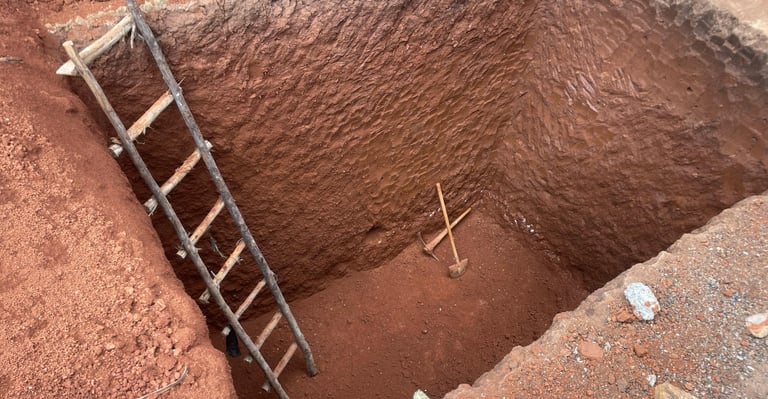

The second step is to set out the columns and cast a concrete bed at the bottom of the pit
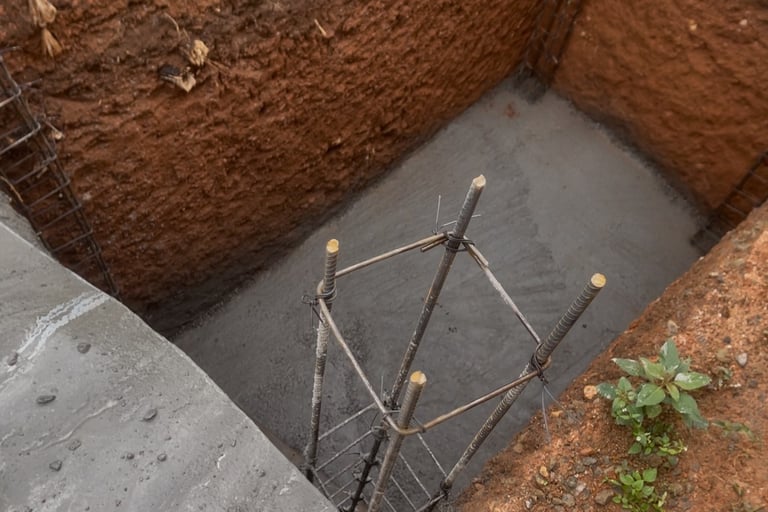

The third step is building the walls in a header bond.
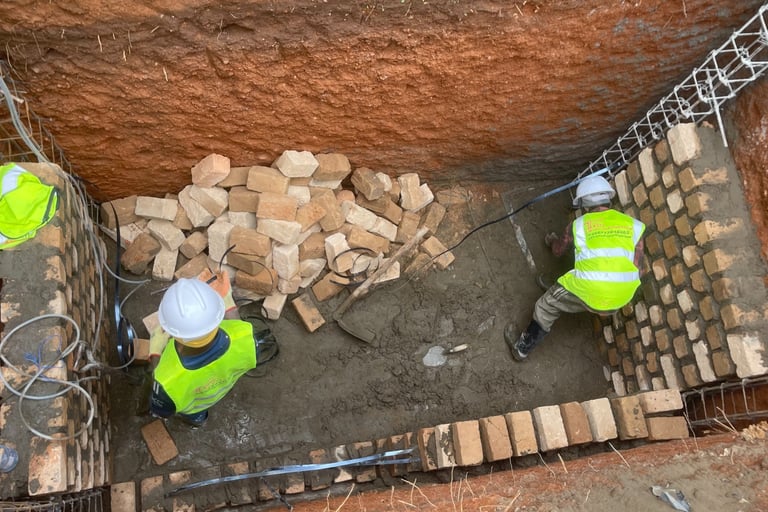

The forth step is to cast concrete for the intermediate ring beam in the middle of the pit


The forth step is to cast concrete for the intermediate ring beam in the middle of the pit
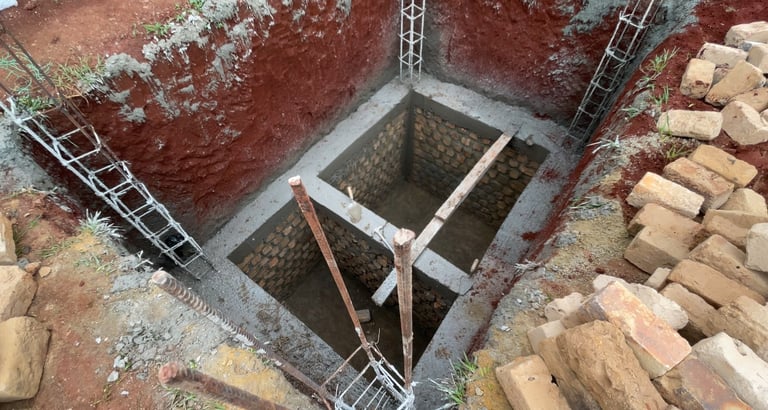

The fifth step is to build wall on top of the beam
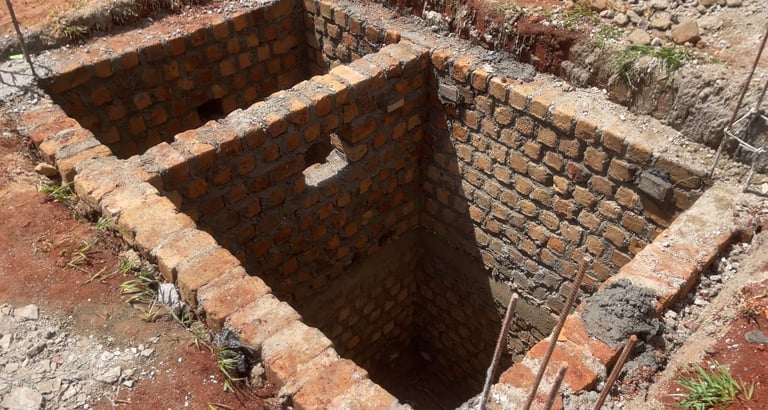

The 6th step is to plaster the walls
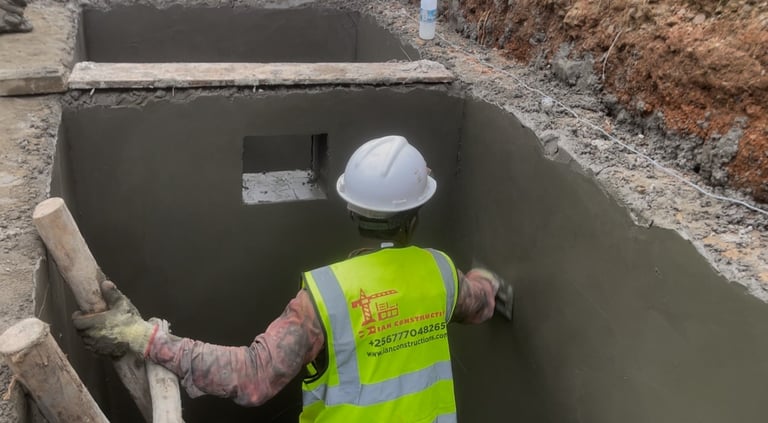

The 7th step is to do shuttering or formwork for the top slab
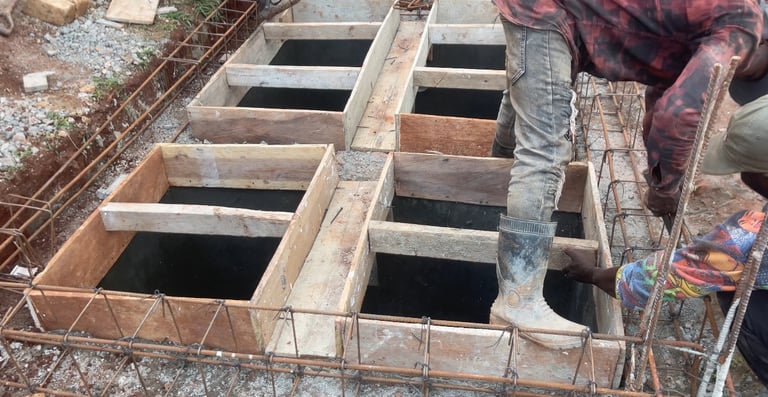

The 8th step is to lay DPM or polythene sheeting on formwork or the timber
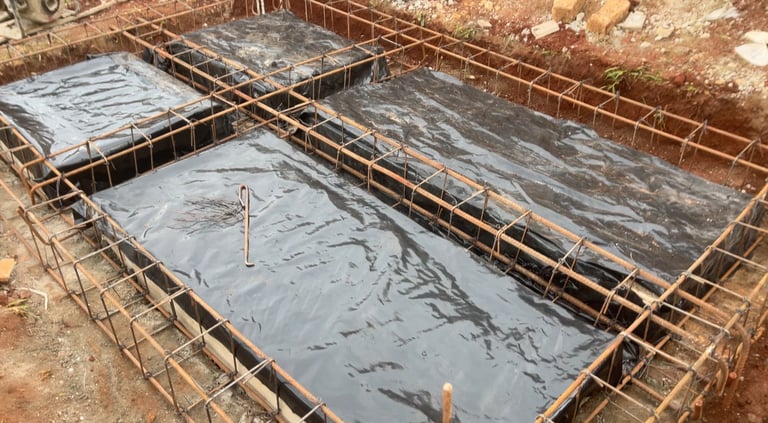

The 9th step is to do steel reinforcement for the top slab
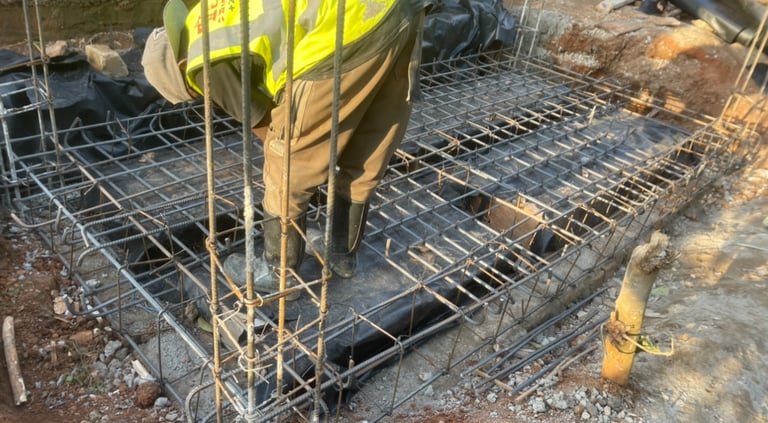

We use a single mat reinforcement like this one if the septic tank I located at the backyard of the house
Then we use a double mat reinforcement when the septic tank is located along the driveway or in the parking where cars are going to be parking
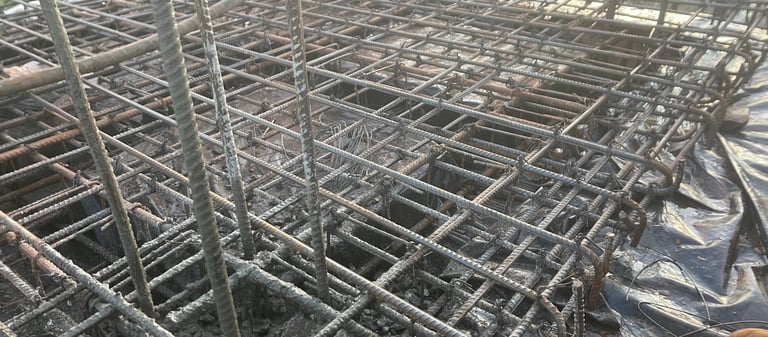

(double mat reinforcement)
And the last step is to cast concrete for the top slab
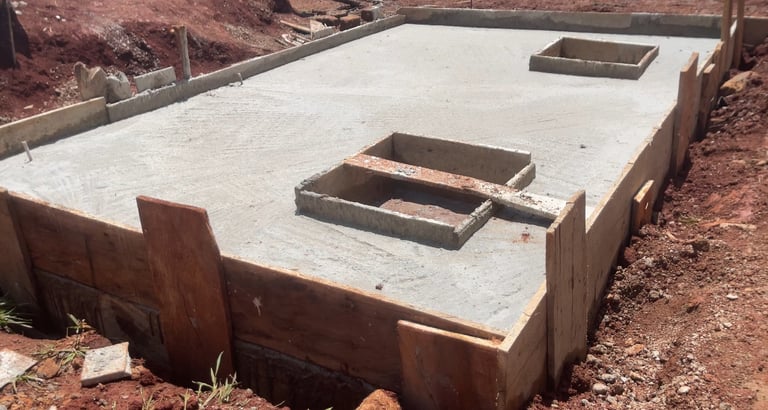

Also be sure to fill the soak pit with hardcore or stones with its heavy-duty pvc pipe at the centre of the pit
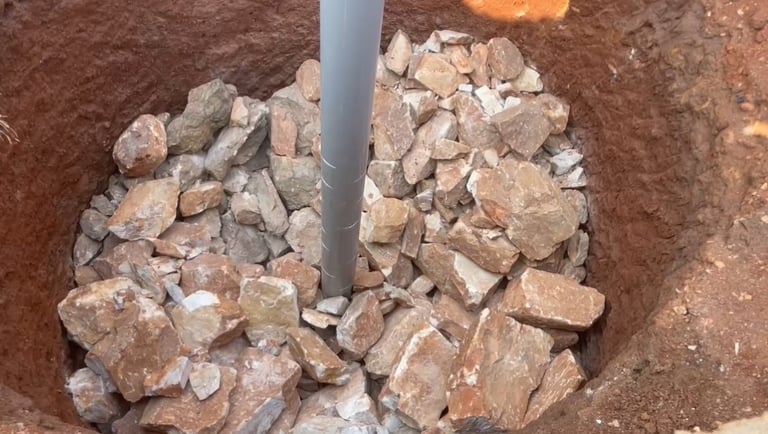

You also have to do the plumbing in such a way that only sewage from the toilet goes into the septic tank and then any other wastewater directly to the soak pit.
Also ensure that all toilets from all parts of the house connect to one inlet pipe to enter into the septic tank
Then all wastewater from all parts of the house must join at this manhole at the outlet side to enter into the soak pit
Meaning sewage from the toilet will be in one pipe and wastewater in another pipe
Ensure that the pipe taking sewage is always at a lower level than the one taking wastewater.
Provide the septic tank with pipes for aeration and also traps to stop smells within in the plumbing system
We have to position manholes in such way that at every point we are changing direction of a pipe, we install a manhole
So this is a manhole here; this is another manhole here since we are changing direction, same hire, and also here. we line them up until we reach the septic tank
When building these septic tanks, you have to ensure that the base, or its bottom, is sloped.
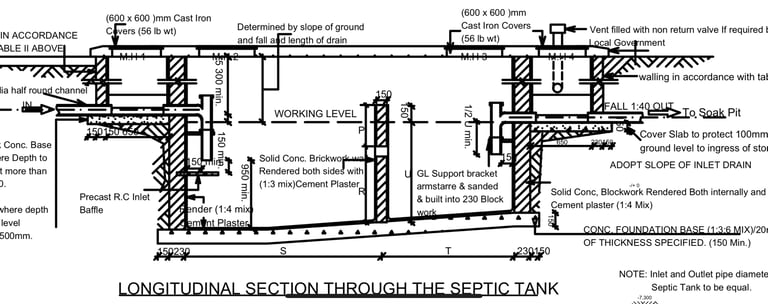

Sloping the base toward the inlet side ensures that sludge and solids settle away from the outlet, which:
· Prevents clogging of the outlet pipe
· Helps only clear effluent (middle layer) exit to the soak pit or drain field
· Protects the soak pit or leach field, which can fail if solids escape from the tank Similarly, when building a single-chamber septic tank, procedures remain the same, only that this one has no separating wall in the middle, but everything else remains the same.
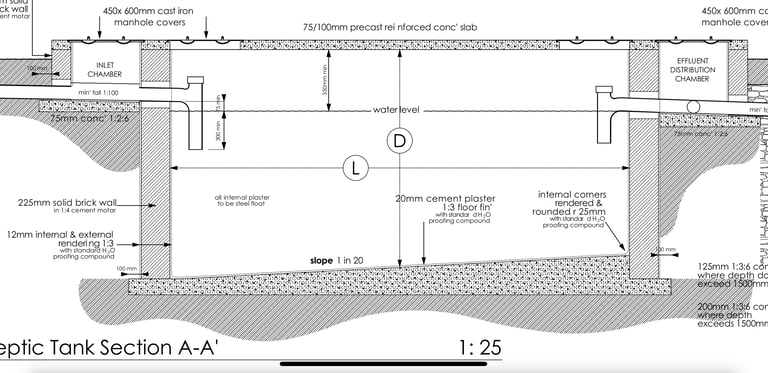

It also has a slopped bottom to trap all solids in one place to prevent anything that might want to clog the system
In case you want to buy these customized septic tank drawings, and to make for you a BOQ for your septic tank project, and you really want to build your septic tank the right way the link is in the description
In summary
We have learnt
1. How a septic tank actually works:
A septic tank separates solids, liquids, and scum, allowing bacteria to break down waste before sending the clean effluent to a soak pit.
2. How to maintain your septic tank to keep it healthy:
Avoid flushing non-biodegradable items, and always fill the tank with water before use to support bacteria and system function.
3. How often to pump your septic tank:
If built poorly, pump every 3–5 years; if built correctly, it may never need pumping even after 40 years.
4. Septic tank costs:
Pumping a 5000-liter septic tank costs about $80 depending on location.
5. How to build a septic tank the right way:
Use proper construction steps, a two-chamber design, and a sloped base toward the inlet and use proper workmanship and good builders to avoid future problems
Thank you so much for reading this article till the end. In case you want us to help you build or want to buy septic tank drawings or plans, contact us.
To buy or purchase the drawings or plans for your septic tank project, 👉 email me at ian@ianconstructions.com or WhatsApp +256777048265.
Affordable Packages: Basic Package for only $25 | Premium Package for only $40 usd What you get: 1. PDF plan for your septic tank (highly detailed and professionally drafted)
2. Free bill of quantities, the total cost, and a list of materials required specifically for your septic tank project
3. Free consultation when executing your septic tank project from start to finish
4. Site Evaluation Guidance—Advice on the best location for your septic tank based on soil type, slope, and drainage conditions.
5. Customized Modifications—Minor adjustments to the design to fit your specific site requirements.
6. Videos and Photo Tutorials—You get exclusive access to photos and videos from my past projects, giving you a crystal-clear view at every stage to confidently guide you through your project.
7. Maintenance Guide—A detailed manual on how to maintain the septic system for longevity and efficiency.
8. Cost-Saving Tips—Expert advice on how to reduce costs without compromising quality during construction.
9. WhatsApp Support—Exclusive support via a private WhatsApp chat where you can ask questions and get real-time advice when building your septic tank.
10. Discount on Future Construction Plans—A special discount on other construction drawings (like house plans, soak pits, or drainage systems) for returning customers.